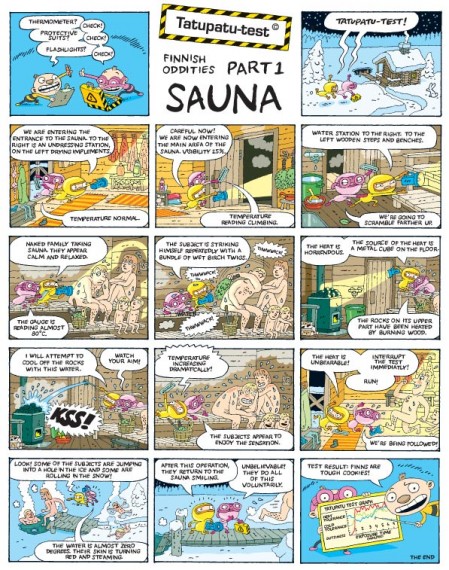Tag: children’s books
Esko-Pekka Tiitinen: Villapäät [Woollyheads]
3 March 2009 | Mini reviews
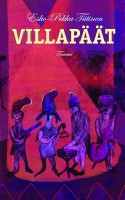 Villapäät
Villapäät
[Woollyheads]
Helsinki: Tammi, 2008. 134 p.
ISBN 978-951-31-4397-8
€ 17, hardback
Amid the angst and tangled human relationships that seem to dominate juvenile books, Villapäät provides young readers with ideals and the clothes to go with them, but eschews a market-driven focus on the self. 15-year-old Timppa and his friends form a band, and soon The Woollyheads will be the star of a charity fundraising concert. The global crisis and selfless relief work acquire a human face when Timppa sees a video on the life of Henry Dunant, the founder of the Red Cross – the only ‘trauma’ Timppa himself suffered as a child was caused by swallowing a Lego block. An important subsidiary role is played by a perceptive teacher who channels the youth into a beneficial, creative hobby. Esko-Pekka Tiitinen (born 1945) was awarded the 2008 Finlandia Junior Prize for Fiction for this book, his 16th.
Raili Mikkanen: Pähkinäpuinen lipas [The walnut wood box]
3 March 2009 | Mini reviews
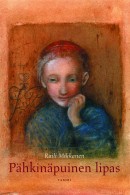 Pähkinäpuinen lipas
Pähkinäpuinen lipas
[The walnut wood box]
Helsinki: Tammi, 2008. 205 p.
ISBN 978-951-31-3855-4
€ 17, hardback
In this vivid juvenile novel, third in the series set in the 17th century, there are surprising points of comparison with the lives of young people today. The three daughters of the healer Briita seek a place of their own in a small rural community after their mother’s death. The youngest, Anna, inherits her mother’s walnut wood box. Unlike her peers, Anna is able to read and write, and the old documents found in the box explain why Briita was a violent mother who sought to relieve the pain of her life with medicinal herbs; her daughters are finally able to understand and forgive her. Through her sympathetic main character, Mikkanen (born 1941) skilfully constructs the image, familiar from classical literature, of a young woman who attains success despite her lowly origins.
Annika Luther: Brev till världens ende / Kirje maan ääriin [Letter to the ends of the earth]
3 March 2009 | Mini reviews
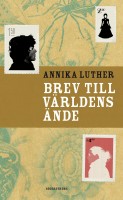 Brev till världens ände
Brev till världens ände
[Letter to the ends of the earth]
Helsingfors: Söderströms, 2008, 184 p. .
ISBN 978-951-52-2566-5
€ 18, paperback
Kirje maan ääriin
Helsinki: Teos, 2008, 197 p.
Suomentanut [Translated into Finnish by] Tarja Teva
ISBN 978-951-851-180-2
€ 21, paperback
This story involves the identity crisis of two boys, a discussion of the human ecological footprint and the growing loss of a relationship with nature. Viktor and Jeppe have been friends since childhood until the mysterious Maira upsets the boys’ relationship. Annika Luther (born 1958) is not content to write a traditional triangle drama – instead she seasons it with Viktor’s betrayal, an act committed in a fit of jealousy that has unforeseeable consequences. The novel’s power lies in its ever-increasing tension, as the trust between the boys breaks down. The plotline is occasionally unconvincing, but at the heart of the novel is the fickle human mind, stripped of all its trappings. The book received the 2008 Topelius Prize.
Marja-Leena Lempinen: Punainen lumme [The red lily]
3 March 2009 | Mini reviews
 Punainen lumme
Punainen lumme
[The red lily]
[Helsinki: WSOY, 2008. 232 p.
ISBN 978-951-0-34434-7
€ 21, hardback
16-year-old Ella’s story is told with gusto and vitality. The novel deals critically, in a way that will appeal to young readers, with questions of Internet etiquette, personal protection and the right to one’s own body. Lempinen depicts the sexual exploitation of a young girl in realistic terms, but does not over-dramatise it. Ella, however, needs to regain her mental equilibrium in a psychiatric hospital, with the help of the understanding staff. The gift of a red lily she receives from friends develops into a beautiful symbol of her gradual attainment of her sexual identity. As in her earlier novels for teens, Lempinen (born 1950) gives an important role to the experience of nature, and this is a leading factor in Ella’s recovery.
Jukka Laajarinne: Elina vieraalla maalla [Elina in a foreign country]
3 March 2009 | Mini reviews
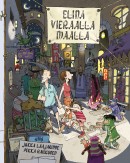 Elina vieraalla maalla
Elina vieraalla maalla
[Elina in a foreign country]
Kuvitus [Ill. by]: Pekka Rahkonen
Helsinki: WSOY, 2008, 25 p.
ISBN 978-951-0-33983-1
€ 21, hardback
Elina is of preschool age when her parents receive a two-year posting, in the fictional country of Kumarkand. After Elina’s initial enthusiasm, the foreign culture frightens her. But when the time comes to go back to Finland, Elina misses Kumarkand and the close friends she has made there. This picture book deals with a timely theme that affects more families than it used to. The intersection of one’s own national identity with a foreign culture is given nuanced, humorous expression by the work of the cartoonist Pekka Rahkonen. Jukka Laajarinne (born 1970) does not lapse into the obvious, but compresses the essential. The snippets of ‘Kumarkand language’ encourage adults reading the book aloud for children to invent some miniature drama for them.
Markku Karpio: Myrskyvaroitus [Storm warning]
24 February 2009 | Mini reviews
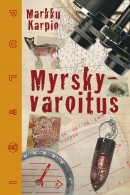 Myrskyvaroitus
Myrskyvaroitus
[Storm warning]
Helsinki: Otava, 2008. 237 p.
ISBN 978-951-1-23000-7
€ 12, hardback
The main character’s quest for identity is a permanent theme of books for children in early adolescence. 11-year-old Emil, who lives with his mother in the outer Finnish archipelago, drifts into an emotional storm at an important moment in the construction of his identity. A storm warning on the radio means Emil’s African father will not be able to reunite with his son. The novel depicts the identity problems encountered by children of parents from different cultural backgrounds and their need for understanding from a wider perspective. A sub-plot concerns Emil and his new friends, and the strengthening of trust and tolerance between them. Markku Karpio (born 1961) portrays young boy’s tentative explorations sensitively.
Tuula Kallioniemi: Rottaklaani [The rat clan]
24 February 2009 | Mini reviews
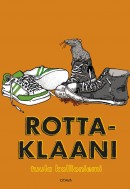 Rottaklaani
Rottaklaani
[The rat clan]
Helsinki: Otava, 2008. 192 p.
ISBN 978-951-1-23159-2
€ 16, hardback
Tuula Kallioniemi (born 1951) manages to deal with difficult issues without resorting to conventional solutions. Ykä, who is nearly 12, suffers from the normal anguish of early adolescence until the CP [cerebral palsy]-disabled Sami pushes his wheelchair into Ykä’s life. The boys decide to get the better of Antikainen who is bullying Sami, but in order to carry out their plan they need the help of quadraplegic Pete and Susanna, who has MBD [minimal brain dysfunction]. Kallioniemi’s literary prescription for the prevention of illness in young people is a simple one: we must all be friends with one other, be allowed to express wonder out loud, and remember that laughter is the best therapy. Kallioniemi’s merits are her verbal skills and her natural cultivation of situation comedy.
In a class of their own
31 December 2006 | Children's books, Fiction
Extracts from the children’s book Ella: Varokaa lapsia! (‘Ella: Look out for children!’, Tammi, 2006). Interview by Anna-Leena Nissilä
There was a large van in the schoolyard with a thick cable winding its way from the van into the school. It was from the TV station, and the surprise was that they wanted to do a programme about our teacher, believe it or not.
The classroom was filled with lights, cameras, and adults.
‘Are you the weird teacher?’ a young man asked. He had a funny, shaggy beard and a t-shirt that said ‘errand boy’.
‘Not nearly as weird as your beard,’ our teacher answered.
‘Can we do a little piece about you?’ the errand boy asked.
‘Of course. A big one even. I’ve been expecting you, actually. Is it some educational programme?’
‘Not exactly.’
‘A substantive discussion programme, though?’
‘Not exactly.’
‘A documentary about our contemporary educators?’
‘Not quite.’ More…
Animal crackers
30 June 2004 | Children's books, Fiction
Fables from the children’s book Gepardi katsoo peiliin (‘A cheetah looks into the mirror’, Tammi, 2003). Illustrations by Kirsi Neuvonen
Rhinoceros
 The rhinoceros was late. She went blundering along a green tunnel she’d thrashed through the jungle. On her way, she plucked a leaf or two between her lips and could herself hear the thundering of her own feet. Snakes’ tails flashed away from the branches and apes bounded out of the rhino’s path, screaming. The rhino had booked an afternoon appointment and the sun had already passed the zenith.
The rhinoceros was late. She went blundering along a green tunnel she’d thrashed through the jungle. On her way, she plucked a leaf or two between her lips and could herself hear the thundering of her own feet. Snakes’ tails flashed away from the branches and apes bounded out of the rhino’s path, screaming. The rhino had booked an afternoon appointment and the sun had already passed the zenith.
When the rhinoceros finally arrived at the beautician’s, the cosmetologist had already prepared her mud bath. The rhino was able to throw herself straight in, and mud went splattering all round the wide hollow. More…
Looking for Moominpappa
Issue 2/1994 | Archives online, Children's books, Fiction
Tove Jansson wrote the first Moomin book in the dark days of Finland’s Winter War in 1939. This extract, from Småtrollen och den stora översvämningen (‘The little trolls and the big flood’, Schildts, 1945, 1991), tells the story of how the Moomins found their home
It had become very hot late in the afternoon. Everywhere the plants drooped, and the sun shone down with a dismal red light. Even though Moomins are very fond of warmth, they felt quite limp and would have liked to rest under one of the large cactuses that grew everywhere. But Moominmamma would not stop until they had found some trace of Moomintroll’s Papa. They continued on their way, even though it was already beginning to get dark, always straight in a southerly direction. Suddenly the small creature stopped and listened. ‘What’s that pattering around us?’ he asked.
And now they could hear a whispering and a rustling among the leaves. ‘It’s only the rain,’ said Moominmamma. ‘Even so, now we must crawl in under the cactuses.’
All night it rained, and in the morning it was simply pouring down. When they looked out, everything was grey and melancholy. More…

